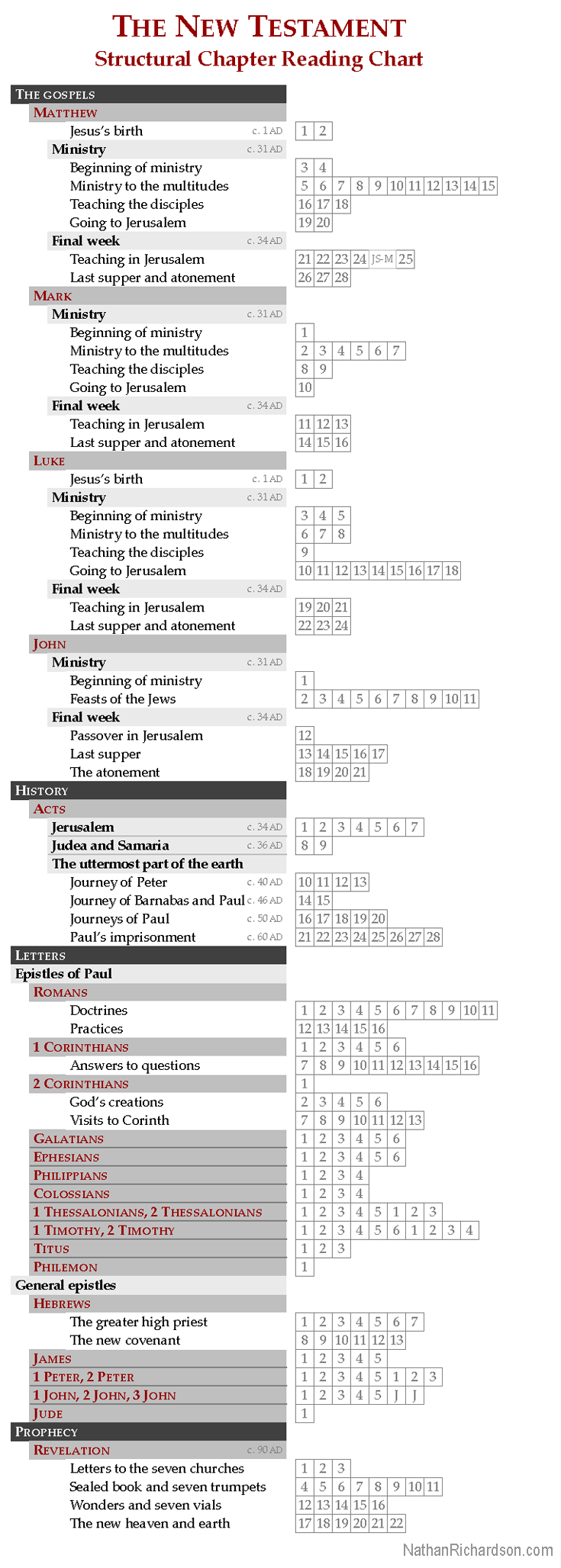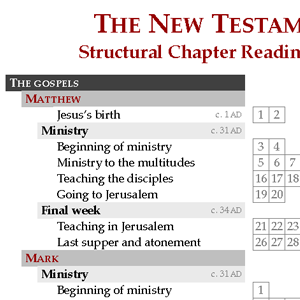
If you’re going to track your progress, you might as well learn something from your tracking chart, right?
This legacy post has been superceded by a newer and better chart. Go to the StoryGuide Scriptures Reading Chart: New Testament. This post is now obsolete.
This reading chart not only helps you track your progress as you read the New Testament; it also helps you learn how the books are arranged, as well as their internal storylines. For example, based on Acts 1:8, the book of Acts has three main divisions: Jerusalem (ch. 1–7), Judea and Samaria (ch. 8–12), and the uttermost part of the earth (ch. 13–28). Likewise, the final division (the uttermost part of the earth) has four subdivisions: the journey of Peter (ch. 10–13), the journey of Barnabas and Paul (ch. 14–15), the journeys of Paul (ch. 16–20), and Paul’s imprisonment (ch. 21–28).
The subdivisions I chose are based in part on the Structured Edition of the standard works—a customized version of the standard works that lays out the (unchanged) authorized text in paragraphs and with headings, so it looks more like a modern novel or textbook. If you’re interested in reading an edition of the scriptures that uses headings to depict this chart’s subdivisions in the actual text as you read, follow the link above. You can download it for free (the New Testament is not completed yet, but the books of Acts and Revelation will be posted soon).
This New Testament chart is a bit different from the other structural reading charts I’ve made because the majority of the books (60%) are so short that they require no subdivisions (e.g., out of Galatians through Jude, only Hebrews is subdivided on this chart). So instead of subdividing these small books, the chart groups them so you can see which ones are written by Paul versus written by other Church leaders (a common way of categorizing them in most New Testament scholarship).
One of the persistent questions was what to do with the four gospels. I am still doing my research, and I think once I’ve come to understand them better, I will give each of the four gospels a unique outline (since they each have unique purposes). But for now, I’ve chosen to use an outline that makes it easy to compare their structures. I’ve based my outline on an article I came across by one Dennis Bratcher, which provides an (admittedly grossly simplified) outline of common shifts in all three synoptic gospels. This outline is useful for comparing the three synoptics, as well as for noticing how they differ from the outline of the book of John. However, I’ll be happier when some day I have the time to give each of the synoptics the attention it deserves and give each one an outline that matches its own purpose and unique structure.
The outline of the book of Revelation is based on articles by Elder Gerald N. Lund. It’s especially helpful to realize that chapters 4–11 parallel chapters 12–16 in much the same way that other visions in the Bible were given in pairs, where the same meaning was expressed twice, through two different sets of symbols. I learned that in my New Testament class from Jeffrey R. Chadwick. Examples he gave included Joseph of Egypt’s two visions of his twelve brothers bowing to him (as sheaves of wheat, then as stars), the pharoah’s two visions of the years of plenty and famine (as cows, then as grain heads), and Daniel’s visions of earthly kingdoms (as a statue, then as beasts). Likewise, John’s revelation appears to represent the same meaning through first a sealed book, then a woman/dragon sequence. Also, the seven trumpets seem to correspond very closely to the seven vials.
All of this I have tried to reflect as concisely as possible in this reading chart, which you can download and print for your personal reading, or share in your classes.
Series: Structural Chapter Reading Charts
- Old Testament
(or just the Seminary Selected Readings) - New Testament
- Book of Mormon
- Doctrine and Covenants

Thank you for doing this. Your lists are a great help in understanding the scriptures better.
Is this still an active site and do you still post new things?
You bet it is. True, my posts have been averaging only about one or two per year for the last couple years; that’s because of a unique job situation I currently have and will have for the next few years. But I am definitely actively creating content that I will eventually post to this website. I also respond very quickly to email and messages sent through my Contact page (see link at the top right). Were you looking for anything in particular?
Love this! Thanks!
Great help appreciate this
Thank you so much for this chart! This is exactly what I needed to see. I was wondering if my reading would end up that I had read the entire New Testament, and I see I will. Thank you for this visual!
Will you soon create a CFM reading schedule for the NT 2023? Waiting patiently!
https://nathanrichardson.com/come-follow-me-reading-schedule-new-testament/